Dutch cuisine…from a polish expat perspective
What comes to mind when thinking about Holland? Some say tulips, windmills, bicycles, weed…some would mention bad weather, some will go for Rembrandt, van Gogh, sophisticated still life painting and some will associate this country with gay pride and rave parties, or maybe van Halen or Vengaboys? Everyone can think of something. Not much comes to mind though, when asked about signature Dutch food (space cookies don’t count). What do Dutch people eat? What were my cultural shocks when I moved? What Polish products am I missing?
Join me for an extremely subjective culinary journey through the flatlands!
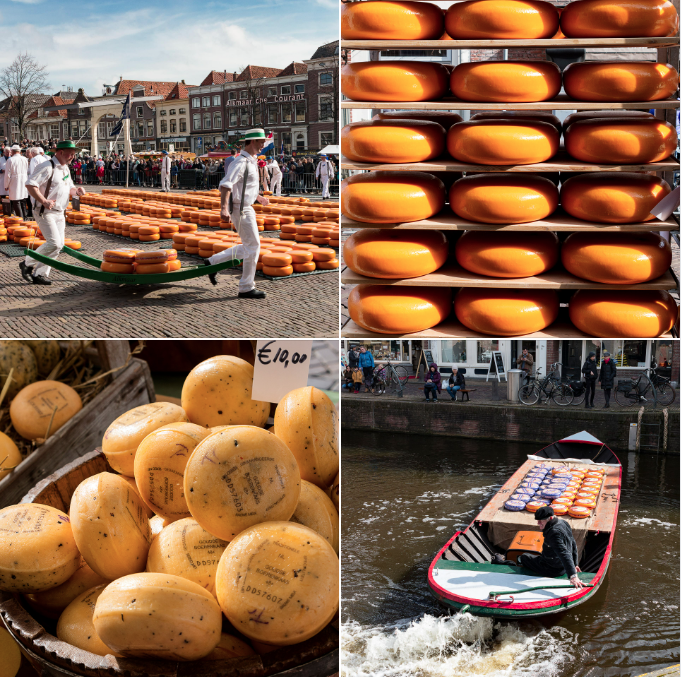
Breakfast
The most important meal of the day – what is a Dutch breakfast like? When I moved to the Netherlands I was struck by the supermarket shelves full of a huge variety of chocolate chips of all shapes and flavours. But these aren’t destined for cakes but … for bread. Yes: take a slice of bread, spread some butter, add sprinkles (called hagelslag) – congratulations, you’ve just made yourself a Dutch breakfast. I’m still in shock, even while putting those words down. Dutch people: why? What is wrong with you? That was definitely a huge culture shock for me!

Lunch time
Broodje kaas – no surprises here, it’s bread and cheese by itself…well, maybe with some butter. Is it possible to eat exactly that at work, every day, for 30 years? Turns out it is! If you bring yourself some warm lunch (like a soup or casserole) Dutch people will give you a suspicious look. What do you have here? Nice, something different every day, nah, too much hassle – broodje kaas alsjeblieft!
Dinner
Dinner – for most Dutch people this is the most important meal of the day and it’s at 18:00, period. Don’t visit your friends at that time, they will be eating and no, they won’t want to share. Dutch people are practical, even pragmatic, so preparing food shouldn’t be any kind of hassle. If they actually cook (not order) they can find a huge variety of pre prepared/pre cooked/pre chopped/pre packed meals and ingredients in the shops. Throw it in the oven/microwave/on a hot pan – the preparation should last for 15 minutes tops. I get it, we’re all busy, not everyone likes to cook…convenience meets less than perfectly eco -friendly plastic packaging – all those trays and bags the food comes in makes me a bit anxious.
Let’s say you do want to prepare a traditional Dutch meal at home. What would it be? Here are some signature dishes with my subjective ratings:
Stamppot – the crown jewel. This dish is a combination of different cooked vegetables that are later pan fried and mashed in the process. That’s the base: a chunky puree made mainly from potatoes and carrot/kale/cabbage/leek/endive. You top it with a cooked rookworst – a thick, smoked sausage, and pour some gravy all over the top. I’m Polish, so the rookworst does not meet my inflated sausage standards and the gravy is 95% of times from a package…rating: 6/10
Mosterdsoep – sounds weird but it’s actually good. It’s a chicken or vegetable broth with onions, leek, sweet cream and mustard. Blended smooth. Often served with crispy bacon chunks and some chives. If you make it from scratch, with good quality chicken stock, it’s a tasty meal. I’m Polish, I love soups, this one is original and tasty, rating: 7.5/10
Erwtensoep – very similiar to Polish „grochówka” – the thick, yellow pea soup. Grochówka is better but the Dutch, fully homemade version gets an honest rating of 7.5/10
Bami/nasi goreng…wait, what? Well, Indonesia was a Dutch colony and indo cuisine is very popular in the Netherlands. It’s like Indian curry in the UK. There are many amazing Indonesian restaurants and specialty delis all over the country plus a huge, supermarket variety of authentic ingredients for making these signature dishes at home. Dutch people like to order it on the go, but do make it at home as well. My rating: 8/10
Roti – another colonial influence, this one is from South America, from Surinam precisely. It’s a savory, thick pancake with hard boiled egg and chicken/beef/veggie curry. I prefer the authentic version, the most popular homemade ones are very often adjusted to the local palate…so a little bit dull. It’s a festive dish people cook at home (and of course consider it Dutch food). Good surinamese version gets from me an 8/10
Street food and snacks
Dutch people like to hang out in the town and with all the beers and biking involved they get hungry at some point. Street food and pub snacks are very popular, though you might not have heard about many of them.
Let me guide you through the highlights. A little introduction first. There was a popular reddit online discussion: describe your national cuisine in one sentence. The Dutch top ranked answer was “just throw it in the deep fryer”. Funny? A bit, but it’s actually very accurate. Snacks/street food in NL really are like that. Let’s start with an absolute classic:
Bitterballen – mandatory in every pub. Small, deep fried balls served with mustard. How to describe the filling? Imagine a super thick bechamel sauce but with milk partly replaced with beef broth and with tiny slow cooked beef chunks in it. The mixture is formed into a small ball (gives you an idea how thick it is), then breaded and deep fried. Savory, crunchy on the outside, creamy on the inside. Not the healthiest of snacks. In any case, I’m not Dutch so I don’t eat it at every social gathering (like you NL savages), but I do like it a lot. Rating: 8.5/10
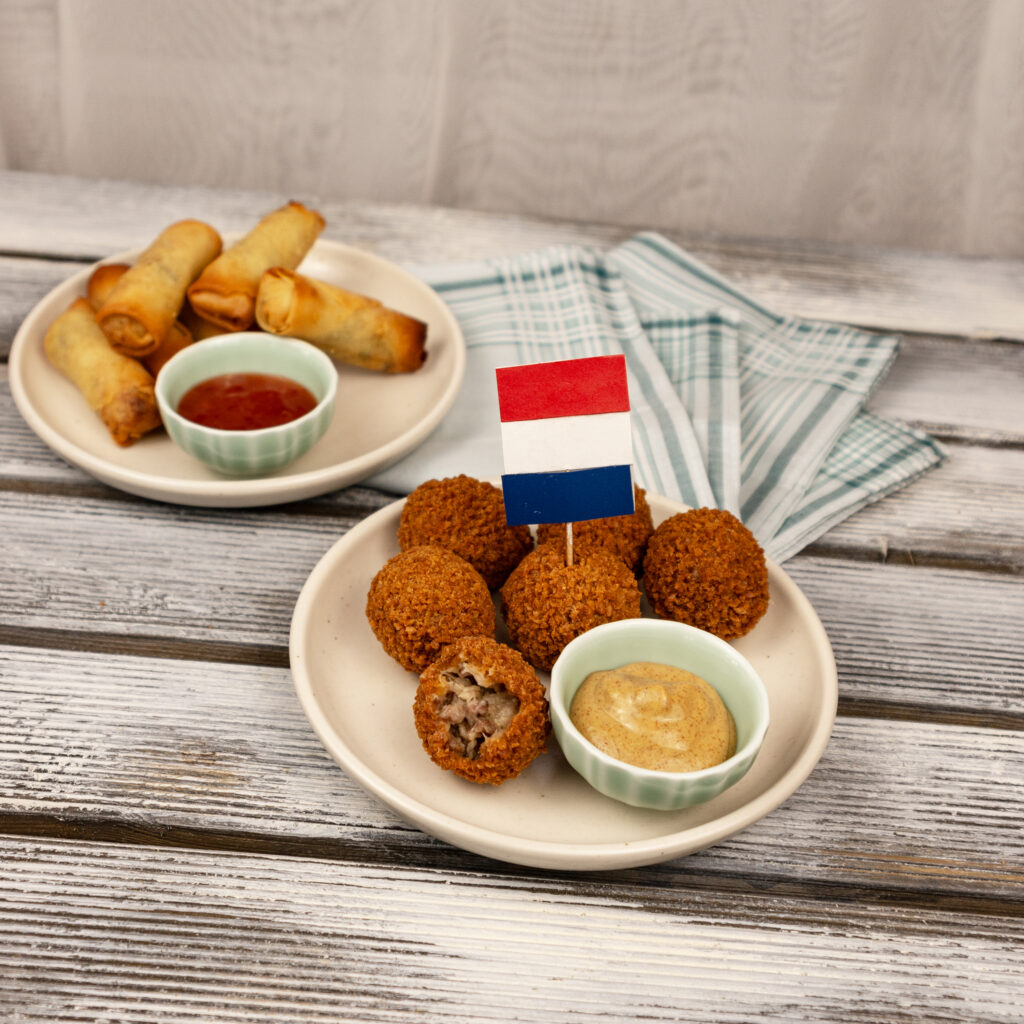
Frikandel – after this review all Dutch readers are going to ban me forever.
It’s deep fried minced paper…I mean meat sausage…served with or without bread, sometimes also comes wrapped in puff pastry. I don’t trust the way it looks, smells or tastes, so sorry guys: bad, low quality fast food with an overall rating of 2/10
Garnalen kroket – yes, another deep-fried classic. Similar to bitterballen (the principal is the same), it comes in a cylindrical shape and with shrimps instead of meat. Served with sweet chili sauce. Not bad but bitterballen are way better. Rated 6.5/10
Loempias/spring rolls – the Dutchies like to wrap a lot of things in the spring roll pastry. Cheese (of course), veggies, chicken, shrimps – wrap it and put it in, yes, you guessed it: the deep fryer. Overall pub snack rating: 6.5/10
Kibbeling – Dutch version of fish and chips, only it comes without chips (you can always order them on the side). This is one of my favourite Dutch street foods. Bite sized pieces of cod in batter served with variations of tartar sauce. With crispy and perfectly seasoned batter, moist, tender fish plus a dipping sauce, all freshly made, in front of your eyes – what’s not to love about it? Rating 9.5/10

Harring – the real, not “a’la” matjas herring. Love at first bite. Small pieces of raw, young herring, I call it the dutch sushi. Sprinkled with finely diced onion, served with a pickle on the side or in a hotdog bun. But the real Dutch way of eating it is: grab it by the tail, tilt your head and gradually non, nom, nom . For some people it might be a shocking snack but I’m Polish, I love „śledzie” and this is the F1 of herring. They are perfect for making any variant of the Polish „śledź” recipes too: in oil with onions, in creamy sauces – they elevate any herring dish. Rating 10/10
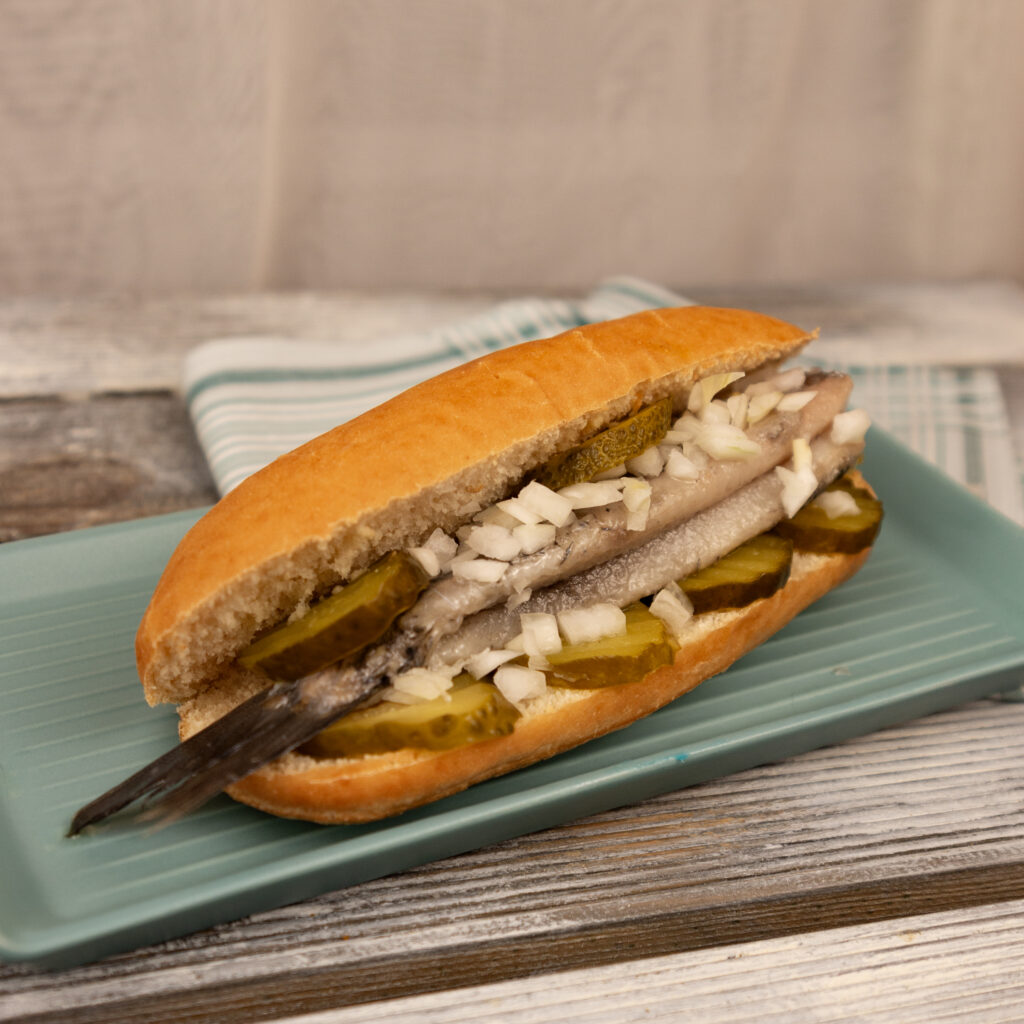
Let’s move onto sweet treats. A general note: Dutch people love sugar. The amount of sugar in any cake or cookie is simply mind blowing. Not necessarily a good thing, as any dessert/jam/sweet sauce is just sooooo sweet you can hardly taste anything else. Apple pie? Sugar and cinnamon, with a hint of an apple flavour. Tiramisu, cheesecake…any cake recipe, even ice cream is adjusted to those sugar addicted palates. Not my cup of tea and not my sugar level, I bail out!
What are the Dutch sweet classics?
Olliebollen – a Christmas treat, similar to the Polish „pączki” but heavier and less fluffy. A yeast cake with no filling, deep fried (of course). There are many varieties: plain, with raisins, with frosting or you can buy them cut like a hot dog and filled with custard (my favourite version). Sprinkled with icing sugar…fortunately only on demand 😉 Rating 7/10
Poffertjes – a street food classic. Tiny, fluffy pancakes, made in a special pan with small, separate dimples for each cute, bite size piece. Served with butter, sugar syrup and of course…a tiny sprinkle of icing sugar on top. Kid’s favourite, but not mine. Rating: 6.5/10
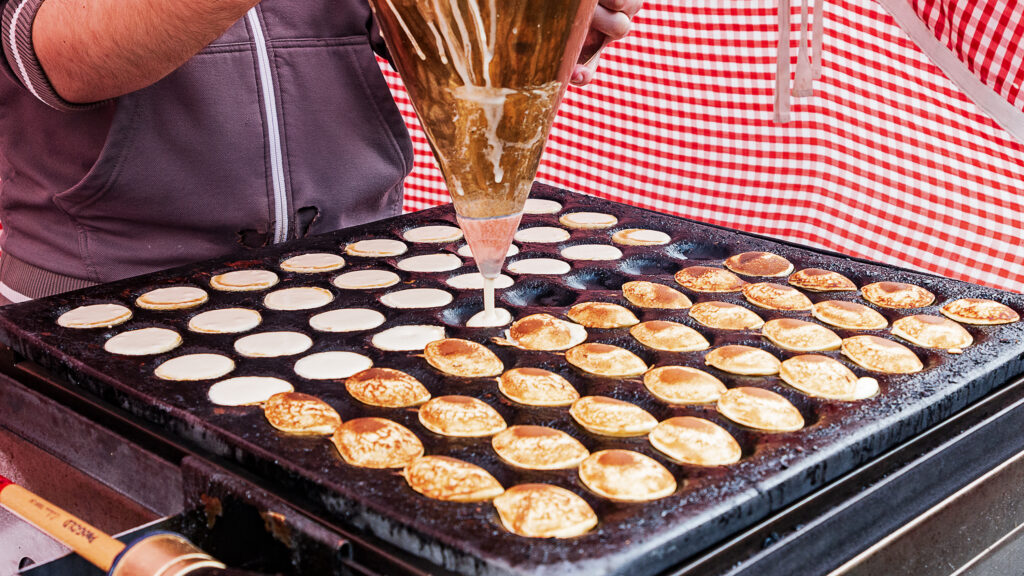
Stroopwafels – you can find them in Sweden, Denmark, Belgium but it’s actually a Dutch invention. Two layers of thin, round, baked waffles held together by a caramel syrup. Again, a bit too sweet for my liking but from time to time, as a „lid” to a nice mug of bitter tea…I rate them 7/10 probably lower than most people would.
We browsed through the Dutch highlights but what about the Polish touch?Am I missing something abroad? Are Polish products hard to get? What do my Dutch friends say about Polish food?
There are many Polish shops in the Netherlands (also online ones that deliver straight from Poland), so whenever I miss a good sausage or kabanosy, traditional hams, savoury dairy products, salty brine pickles, pierogi (one: pieróg, multiple: pierogi, there is no such thing as pierogies people) or proper sourdough bread I have many options. I would say I miss the huge supermarkets and the general wide range of products – I need to visit a Dutch supermarket, an oriental shop, a Turkish and Polish shop to have my pantry fully equipped.
Is there anything I really miss then? The fresh, aromatic fruits in their peak season, especially strawberries. Dutch fruits come from abroad or from a greenhouse…it’s not the same.
Dutch people and Polish food? It’s a good match. Żurek and kabanosy stole everyone’s hearts. My guests also enjoy barszcz, pierogi, placki ziemniaczane (potato pancakes), polish stews/ goulashes and various meat chops…Polish cake recipes require some extra sugar for them though.
Cultural differences? Let’s take a closer look. First from the Dutch perspective.
- An invitation for dinner (not before or after). Dutch people are friendly and helpful but if they meet for dinner it’s mostly eating out (make it short). Homecooked, celebrated dinner at home is only for the family (and at six). Parties with food…not really, as you just had dinner at 6 p.m. so you’re not hungry at 8, right? The general Polish (and Mediterranean) concept of eating, talking and drinking for long hours needed to sink in the Dutch minds.
- Soup as a starter/first dish. My Dutchies were surprised that a soup can be made of so many different ingredients (just like vodka, we can make a soup out of almost anything) and the consistency of most soups “there is always something swimming in it” – new discovery: soup is not always blended smooth.
- Polish kanapka. Unlike broodje kaas, we only take 1 slice of bread, put a lot of ingredients on it…and we don’t top it with another slice of bread. This is very extravagant 😉
- Food at important social gatherings. On a Dutch wedding/funeral/birthday party you can expect some mix of deep fried snacks, tops. Sometimes there is no food at all (you had dinner at home, right?). The amount of meals and rounds of bites served at a Polish wedding was a total shock for our guests, as well as the duration of the fiesta itself.
- Nalewki and the general concept of a fruit infused vodka/homemade alcohol. They love it, they don’t have it (actually now they do, as I’m picking up some skill on that field).
- Polish Wigilia (the Christmas Eve dinner) and the 12 courses. Every year the guest list is getting longer but the first one I hosted was a bit overwhelming for the Dutchies. They could not understand 3 day long preparations to serve a single dinner too, now they come at least a day before and help along.
- The polish “no food waste” obsession. Maybe it’s the Christianity, maybe WW2, maybe the Communism or all the above combined but Polish people hate throwing food away. Dutch people manage their money very well, keep an eye on any discounts (korting korting) and multi pack deals but for some reason they don’t mind getting rid of any food leftovers while we, the Poles, turn those leftovers into new dishes…or we will just force feed you with the last bite, even if you’re full because we don’t throw food away, period!
- 365 potato based dishes – the Dutch people like their ‘taters too, but are a bit mesmerized by the Polish creativity in the topic.Pyzy, kluski, kopytka, kartacze, babki and placki ziemniaczane – an uncharted territory for the mashed potato and fries lovers.
What was weird, unusual and uncommon for me?
- Burgers, burgers everywhere. It is hard to find an “all european”/generic restaurant in the Netherlands without a burger in the menu. Not talking about artisan burger themed places (a fashion that comes and goes) but an average restaurant will, for sure, follow the general burger obsession in this country. Burger on the menu is almost mandatory (like there is no other food).
- The snack wall. It’s a wall made of small, individual compartments, each containing a (of course) deep fried snack, like a frikandel, kroket or burger. Warm fast food vending machine…how crazy is that? Don’t expect quality here – it’s more of a last resort midnight snack in the town, but still quite popular among the Dutch people.
- No proper supper. Kind of logical, if you eat dinner at six, but if you go in the town afterwards you should eat something, right? If you do, it’s mostly the snack bar/snack wall when people get tired during the pub crawl. Polish people eat when they drink (that’s how we survive all the liquor), Dutch people don’t.
- Going Dutch…the saying did not come from nothing and Dutch people really divide their restaurant or pub bills religiously and by the cent… straight away, at the table, with the most essential money transfer app called „tikkie”. One person can pay the whole group’s check but no cheating: every bite you take, every drink you slurp – I’ll be charging you.
- Gouda cheese – not the cheese itself but the pronunciation of the word. It’s not a G, it’s an H in the beginning, so it’s “hauda”…been mispronouncing it my entire life.
- Hagelslag – not even in a million years will I understand eating cake decoration on a slice of buttered bread for breakfast, yes, I had to mention it again.
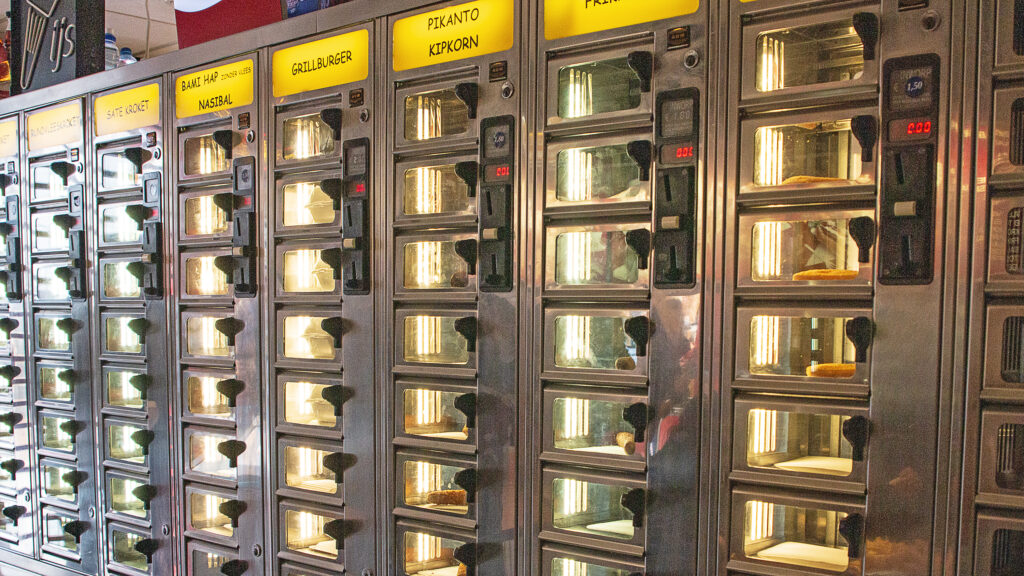
The Dutch people might not have invented such milestones/everyone’s favourites as kebab or pizza (but hey, stroopwafels) or made a really huge impact on the world food scene with their national dishes but they are open to trying new flavours (even if the item is not deep fried…or a burger). The colonial heritage is smoothly incorporated in everyday, simple, hearty, “protestant meals”, making them a bit more exotic and special. Being exposed to another continent’s culinary traditions made the Dutch people prone to novelties. They do like their standard meals but are quite curious about the new flavours too.
Dutchies love to eat out, so in almost every town you can find some decent restaurants, fresh food concepts and gifted chefs with bold ideas.
The vegan and vegetarian scene is also widely represented – all the meaty dishes mentioned above have their non meat equivalents and every supermarket can supply you with good quality, plant based, products.
What do the flatlands taste like?
You should visit and try some Dutch food yourself (make sure to plan your trip between late April and end of September to avoid the “exquisite” weather in full bloom), bite into the classics (and redefined versions of them), try some of the novelties and pick your favourite. Just not the hagelslag – please don’t…just don’t do it, ever!